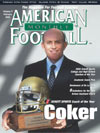Lights... Camera... Action...
Fordham uses an action passing attack to power to the top of the Patriot League
Head Coach, Fordham©
More from this issue
One of
the contributing factors to our program’s improvement from
a 0-win team in 1999 to a 7 win team in 2001 was the development
of a sound base run game and an appropriate complimentary action
passing game. The organization of the action passing game is done
in a manner that serves as an answer to defensive adjustments to
our base run game and provides protection flexibility to our base
pass game.
At Fordham, we feel it is important to have an action pass off of
every base run in our package. The action pass can be one of four
concepts. The four concepts, as we define them, are play-action
passes, run-action passes, nakeds and bootlegs. One or more of these
actions can compliment each base run, but all four will be included
in our weekly game plan menu. This provides potentially needed answers
to defenses and allows for various launch points in the pass game
besides traditional 3-and 5-step passes.
DEFINITION OF TERMS
All of our action passes will fall into one of four categories defined
below:
Play Action Pass - In our terminology a play-action pass involves
a quick run fake by the QB. The QB will set up to the side of the
initial run fake followed by a quick tempo throw. Our play-action
series attacks underneath coverage by putting immediate stress on
the underneath zone defenders by replacing the voided zone created
by the run fake. The timing of the throws and route depth are similar
to our five-step drop game.
Run-Action Pass - Our run-action passes involves a hard run
sell by the QB in an attempt to “sell all eleven.” The
QB’s launch point is to the side of the run fake. The QB’s
progression is high to low in an attempt to create big plays (20-plus
yards). The protection involves seven to eight men to eliminate
potential hot throws by the QB. The timing of the throws and route
depth are similar to a seven-step drop game.
Nakeds - In our naked series the QB’s set up is away from
the initial run fake. The QB gives a hard run fake in an attempt
to create flow from the second level of the defense while getting
the defensive end away from the play to chase the run fake. Our
nakeds involve gap protection responsibilities for our offensive
line and do not account for the end man on the line of scrimmage
away from the fake. The naked can be run back to an open or tight
end surface.
Bootleg - Bootlegs are identical to the naked in terms of
the QB’s footwork and sell of the run. The sole difference
is the protection aspect of the play. In our bootleg series a pulling
lineman will account for the end man on the line of scrimmage away
from the fake. Similar to our naked series, the bootleg game involves
the aspect of misdirection and is designed to take advantage of
the flow created by a good run fake. The progressions in our naked
and boot game are typically low to high.
Lead-Pass Series: An example of an action pass that can fit
multiple categories is our lead-pass series. Similar to most offenses
that incorporate a two-back run game as an aspect of the run game,
we run a lead play. The play incorporates a double team at the point
of attack with an isolation block by the lead back on a linebacker
with a deep hand-off to the tailback. We run two versions of the
lead play, lead draw and isolation, with the scheme of the plays
bring identical but with different tempos. Off of our lead play
we incorporate different play-actions and run-actions to compliment
the lead run.
Protection: The protection of our lead pass series is a turn
back scheme with the offensive line being responsible for the four
down defensive lineman and the Wil linebacker. In this protection
the fullback is responsible for the Mike linebacker and the tailback
for the Sam linebacker. The base protection on lead-pass is a seven-man
protection with the flexibility to block eight defenders by including
the tight end in the protection.
The Protection rules are as follows:
Right Tackle - Pass set man on to outside
Right Guard - Vs. A gap defender - down show hard double
Vs. B gap defender - on
Center, Left guard, and Left tackle - backside gap
Fullback - Sell run with low pad level
- Check releases off Mike linebacker
Tailback - Sell run - Check release off Sam linebacker
The Protection is drawn vs. an under and 4-3 front:
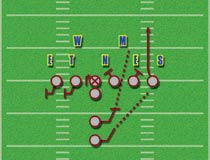 Diagram 1. Vs. Under
Diagram 1. Vs. Under |
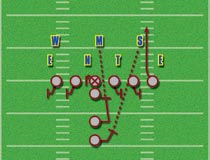 Diagram 2. Vs. 4-3
Diagram 2. Vs. 4-3 |
Routes & QB Progression: Our base lead-pass is categorized
as play-action. The tempo is off a quick run fake and five-step
drop of the QB. When running play-action passes the offensive line
and backs are primary in selling the run. On our base lead pass
the down block on the shade must be hard and low with the demeanor
and steps of the backs being identical to the run play. Everything
must sell the Mike linebacker that the lead play is being run to
trigger a downhill fill reaction and get the Mike to void his zone
coverage responsibility. With the routes we simply replace the Mike
linebacker at a depth of 6 yards with the tight end or slot receiver.
The QB’s progression is to immediately replace the Mike linebacker
with the football as his fifth-step hits the ground. If the tight
end is not open the QB is taught to reset and immediately progress
to read underneath from the fullback to the tailback. As with all
play-actions, the progression attacks the underneath zones that
the run action will affect.
Lead-Pass Post: The same protection and run fake can be applied
to a run-action. Whenever we tag the route of the flanker, it automatically
triggers the run-action aspect of the play. The QB now uses a longer
run fake to try to affect the entire defense with a high to low
progression coming off the fake. The QB will set with greater depth
and the routes will be extended past the depth of the play-action.
An example of a run-action is our lead pass Z post. The Z post automatically
triggers the deeper drop and high to low progression of the QB.
The following are the routes for Lead Pass Z -Post:
Z - Post
Y - Search (10-12 yards)
F - Check Cross
H - Check flat
X - Curl (14-12 yards)
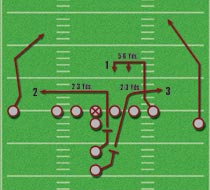 Diagram 3. Lead Pass
Diagram 3. Lead Pass |
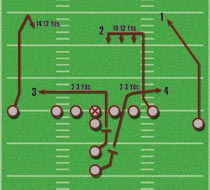 Diagram 4. Lead-Pass Z Post
Diagram 4. Lead-Pass Z Post |
LEAD-PASS Z POST
The QB’s progression off the fake is to immediately look for
the post, to the search, then to the fullback and tailback. The
tight ends route will deepen with the Z-post tag, accounting for
the deeper drop of the QB and where he fits into the progression.
Other route combinations can be run with the lead play that are
play-action or run-action in nature. The lead-pass protection has
proven to be a valuable change up that has complimented our 3-and
5-step drop package. The various tempos of the play has allowed
us to attack a variety of coverages with the lead-pass series which
has made it a staple in our weekly game play menu.
